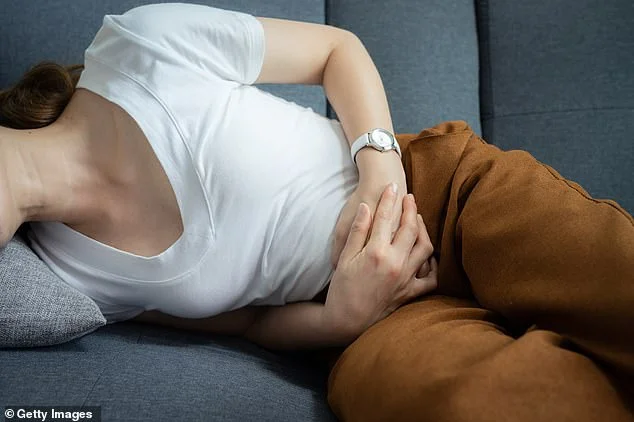I woke up one morning feeling utterly wretched.
My body ached, my head throbbed, and waves of nausea made even sitting up feel impossible.
The day before, it had started with a mild stomach upset.
By now, I was wrestling with fever, chills, fatigue, and a heart that seemed determined to race out of my chest.
At one point, I genuinely wondered: What if I’m dying?
The thought was terrifying. I considered asking my husband, Paul, to take me to A&E, but the idea of waiting for hours in a crowded emergency room felt unbearable.
What I was experiencing was, in fact, a severe flare-up of diverticulitis—a condition I would come to know all too well.
Understanding Diverticulitis
Diverticulitis occurs when tiny pouches, called diverticulae, form in the intestinal walls and become inflamed or infected.
These pouches can range in size from a few millimeters to nearly an inch.
For some, the pain can be excruciating; women often describe it as worse than childbirth.
In severe cases, the pouches can form abscesses or even rupture, leading to peritonitis or sepsis, which can be life-threatening.
By age 80, up to 70% of people have these pouches, yet most remain symptom-free.
Why some people develop inflammation and others don’t remains a mystery, but risk increases from age 40 as the intestinal walls weaken.
Rising Numbers and Misdiagnoses
Diverticulitis is becoming increasingly common.
According to Guts UK, up to one in two people will develop it at some point.
Hospital admissions have more than doubled over the past decade, partly due to an ageing population, but also because of lifestyle factors such as obesity, sedentary habits, low fibre intake, smoking, and certain medications.
Ultra-processed foods may also play a role, though the reasons aren’t fully understood.
One of the trickiest aspects of diverticulitis is its similarity to other conditions like irritable bowel syndrome (IBS).
Symptoms like abdominal pain, bloating, nausea, and changes in bowel habits can be misleading. Blood in the stool is often mistaken for piles.
This overlap can make diagnosis frustratingly slow.
My Long Road to Diagnosis
In 2020, at age 57, I started experiencing repeated bouts of fever and malaise.
Blood tests by my GP showed nothing alarming.
It wasn’t until a severe flare-up in March 2021, when I was shaking and sweating uncontrollably, that I was sent to a gastroenterologist.
Surprisingly, because my pain was relatively mild, I was initially sent home without a diagnosis.
It wasn’t until a subsequent flare-up, when I genuinely feared for my life, that a colonoscopy revealed multiple diverticulae along my colon, confirming diverticulitis.
Debunking Dietary Myths
Managing diverticulitis is as much about lifestyle as it is about medical care, yet misinformation is rampant.
Many are told to avoid high-fibre foods such as beans, apples, bananas, avocados, and carrots, but Guts UK emphasizes these foods actually help by bulking stool and reducing pressure on the pouches.
Avoiding fibre is only necessary during flare-ups or if complications occur.
Similarly, fears about seeds, nuts, or popcorn lodging in pouches have been refuted by multiple studies.
While some people may have individual food sensitivities, these do not cause diverticulitis.
Low-FODMAP diets, popular for IBS, are sometimes suggested but are not recommended for diverticulitis.
During a flare-up, switching to fluids and, if necessary, antibiotics is the safest approach.
In severe or recurrent cases, surgery may be needed to remove affected sections of the gut.
Living with Flare-Ups
I experience four to five flare-ups each year.
The worst hit me earlier this year, when I lost eight pounds in just four days.
Over time, I’ve developed my own strategies: I keep antibiotics on hand, stay hydrated, and focus on rest.
After a flare-up, I reintroduce food gradually, often avoiding fibre until my gut feels ready.
Even outside flare-ups, I’m rarely fully symptom-free.
Fatigue, occasional nausea, and digestive discomfort are now part of my everyday life.
Hope on the Horizon
There is, however, promising news. A new treatment involves surgically closing the pouches with clips inserted via an endoscope under conscious sedation.
Early research from King’s College Hospital shows this method is safe and can reduce both diverticulitis episodes and IBS symptoms.
For sufferers like me, these advancements offer hope for a future with fewer flare-ups and improved quality of life.
Key Takeaways
Diverticulitis is common, often misunderstood, and can dramatically affect daily life.
Accurate diagnosis, proper dietary guidance, and individualized treatment plans are crucial.
For more support and information, visit Guts UK or Bowel Research UK.
Share on Facebook «||» Share on Twitter «||» Share on Reddit «||» Share on LinkedIn